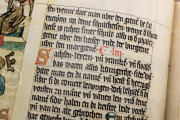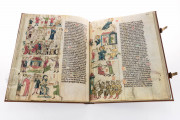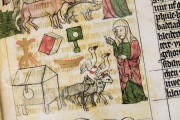The Wolfenbütteler Sachsenspiegel (Mirror of the Saxons) dates back to the third quarter of the 14th century and is the latest of four illuminated manuscripts including the most important German law book of the Middle Ages; the Sachsenspiegel. Only few manuscripts equal the incredible quality of miniatures and the extensive wealth of text included in the Wolfenbütteler Sachsenspiegel. With the best text tradition and rich color-filled depictions, this Mirror of the Saxons is without question, the most precious example of a decorated Sachsenspiegel.
The Wolfenbüttel Mirror of Saxony: the First Vernacular Law Treatise
Few other books have influenced the history of German law as much as the Sachsenspiegel. After centuries of word of mouth tradition, the common laws of the Middle-Ages were eventually put into writing for the first time; thus the Sachsenspiegels were born. Its author, Eike von Repgow, penned the book not in the common language of medieval educated laypeople (either Greek or Latin) but rather in the vernacular of his native lower Germany. By doing so, he crafted both the most important and long-lasting effectual work which is still unsurpassed nowadays, but also an opus representing the first prose written in the German language. Eikes' masterpiece was also able to contrast the ever-growing feeling of the time's legal insecurity born from the power struggles between the Staufern and Welfen dynasties and between the Kaiser and the Pope, all of which happened during the German colonisation of the Slavic populace. Due to the enormous social and political unrest, the only chance for peace and order was that od possessing a written record of all the laws every person had to abide by.
A Milestone in the History of German Law
Eike's text was extremely popular even outside Saxony and it laid the foundation for the birth of the "Deutschenspiegel" (Mirror of the Germans) and the "Schwabenspiegel" (Mirror of Schwabians) in southern Germany. These treatises, which were translated into Latin, Danish, Polish, Tschechenian, and Russian were then taken to the lower Rhine Valley, the Netherlands and spread as far as middle and eastern Europe. The Mirror of Saxony had an incredible territorial effect, covering an enormous life span and was, for this reason, deemed as the authoritative law book for the following seven centuries. At the end of the 19th century it was replaced by the Bürgerliche Gesetzbuch (Civil Law Book).
The Norms for Life in the Medieval Village
The Wolfenbüttel Mirror of Saxony addresses the knightly and rural Saxon populations and contains the laws of the land as well as ownership laws (i.e. the martial law of knights which was extremely important during the Middle-Ages). In the prologue, the author outlines the divine origins of law – "God is the Law, this is why he holds it dear": everyone is called upon in the text to not be led astray from this law "neither for love nor sorrow, rage nor gifts". After the prologue, the laws are divided into three books including 255 articles pertaining to villages, neighbours, the family– and inheritance laws, constitutional laws, criminal law, constitutional laws of the court and procedural law. The second part of the book includes 86 articles dealing with norms of ownership (i.e. proportional ownership between the lord and his vassals).
The Four Illustrated Manuscripts of the Sachsenspiegel
The over 450 preserved manuscripts and fragments of the work that still exist today show the exceptional importance of the Sachsenspiegel in public life during this time. Among them are four particularly opulent decorated codices whose text is flanked by depictions that help clarify the corresponding text. These four manuscripts derive their name from the place where they were preserved. The Heidelburger manuscript dates from around 1300: it includes 30 pages with 310 depictions and it survived only in fragments. The 1336 Oldenburger Sachsenspiegel, has the most complete text of the lot, even though only 44 of the 578 hand-painted miniatures still have intact colours, the rest only containing colourless outlines of characters and objects. However, from mainly artistic point of view, the other two manuscripts are the most important. Both the Dresdner Codex (mid-14th century) and the Wolfenbüttleler Sachsenspiegel (a little later) containing hand-painted pictures of the highest quality depicting real-life scenes with animated facial expressions and gestures of figures as well as a rich amount of gold found throughout.
A Colourful Panorama of Medieval Life
776 painted miniatures are laid out on over 86 folios, giving the reader a splendid and colorful panorama of the laws for everyday life in the 14th century. The depictions are found on each page, on the left-hand side or beneath text. Since part of the painting includes the first word in the accompanying text, the correlation between text and picture is easy to follow. Moreover, the miniatures are more than beautiful illustrations: they also help to clarify and give a better understanding of the Wolfenbüttel Mirror of Saxony. An important cultural and historical significance is found in the additional information included within the pictures themselves. The miniatures depict individuals of various social classes, interior and exterior architecture, weaponry, landscape, household belongings, food and jewellery, all of which are a priceless source for further studying and exploring everyday life in the Middle-Ages.
Can a Law Treatise be a Deluxe Manuscript?
The opulent and exceptional illuminations found on every page that are richly-endowed with gold, the superb quality lettering and majuscules and the meticulous and realistic gothic text-design make the Wolfenbütteler Sachsenspiegel a truly deluxe manuscript. However, its main purpose was its concrete use. This can be seen in the presence of holes, tears and irregularities that indicate the fact that use of the highest quality vellum was not the artist's main concern. In addition, the many darkened pages show repeated and frequent use of the book. We can therefore only assume that the Wolfenbüttel Mirror of Saxonyl was intentionally made for a very important person who used the manuscript to serve its cause.
The Mysterious History of the Manuscript
The Wolfenbütteler Sachsenspiegel was most likely crafted in the third quarter of the 14th century in upper Saxony. Patrons and illuminators are unknown, which is often the case with most medieval manuscripts. After the Wolfenbütteler Sachsenspiegel was completed and for the next 300 years, manuscript's fate remained and continues to remain a mystery. Then it was purchased by Herzog August, the youngest son of the Braunschweig-Lüneburg family and founder of the second and permanent library in Wolfenbüttel. Herzog August even mentions the manuscript in his hand-written "Bucherrad Katalog" (book catalog). The Herzog August Library remains to this day the permanent resting place of the original Wolfenbüttel Mirror of Saxony.
We have 1 facsimile edition of the manuscript "Wolfenbüttel Mirror of Saxony": Der Wolfenbütteler Sachsenspiegel facsimile edition, published by Akademische Druck- u. Verlagsanstalt (ADEVA), 2006
Request Info / Price















